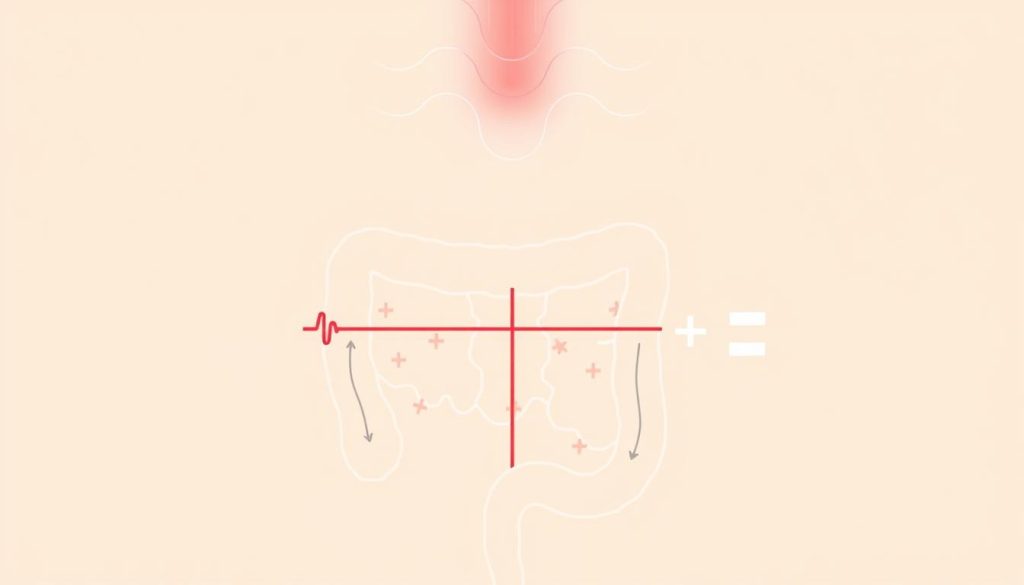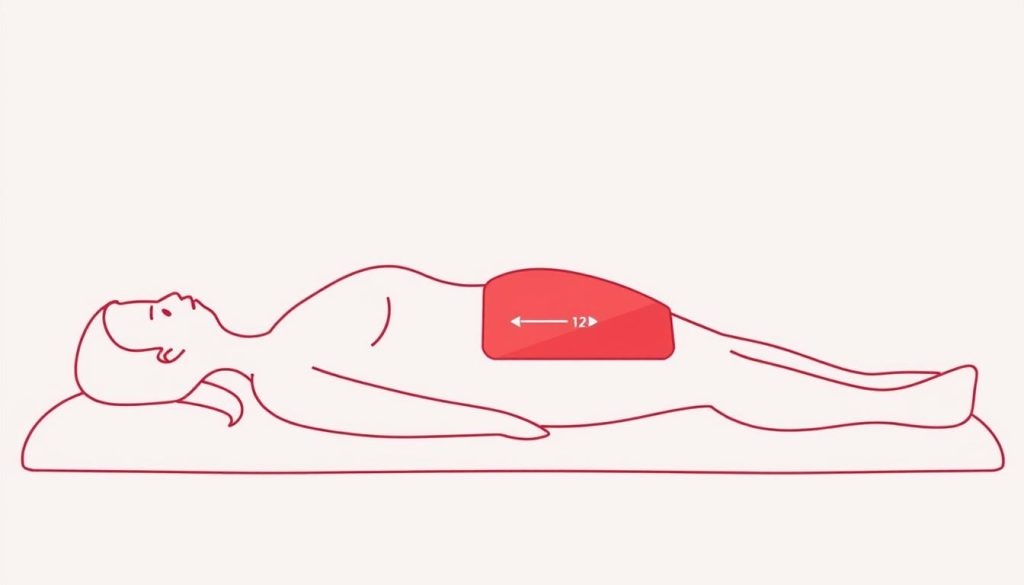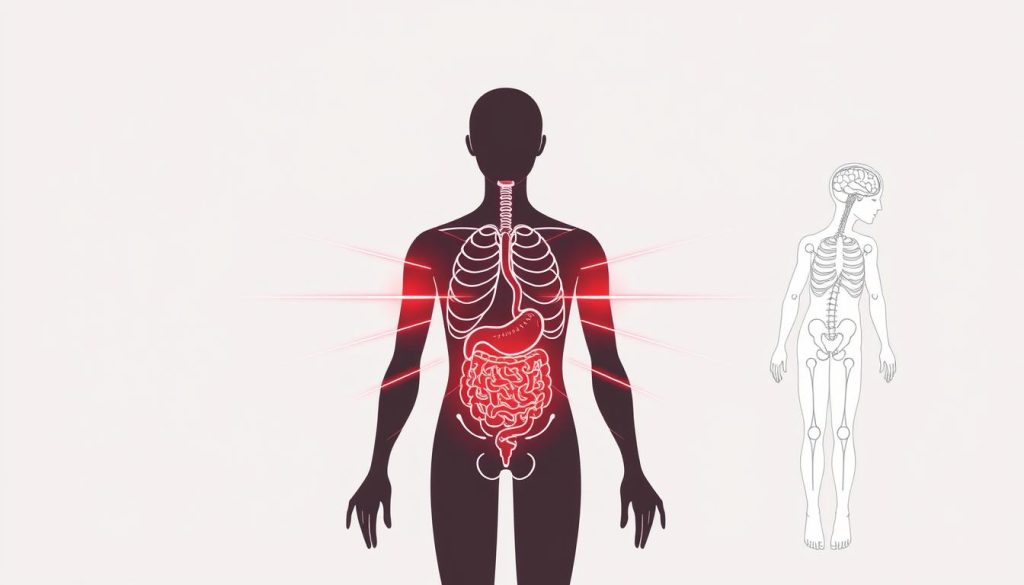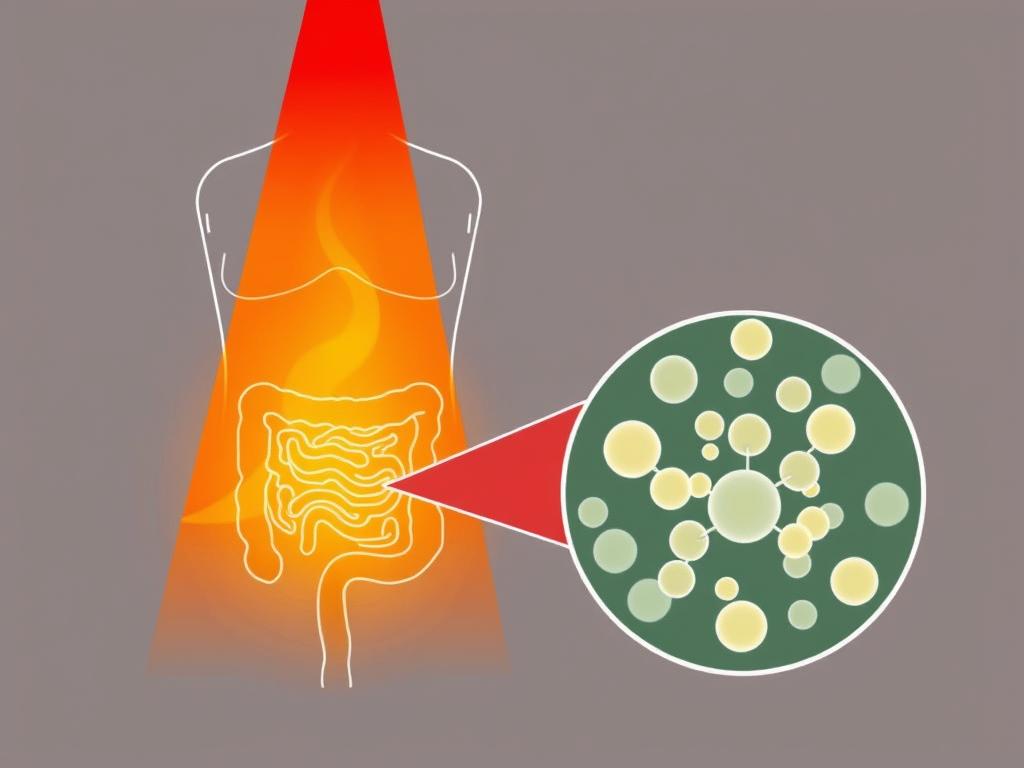Red light therapy (RLT) is emerging as a promising approach for improving gut health, offering a non-invasive method to address digestive issues that affect millions worldwide. This therapeutic technique uses specific wavelengths of red and near-infrared light to penetrate tissue, reduce inflammation, and promote healing at the cellular level.
Recent clinical research has demonstrated RLT’s potential for improving gut conditions. A 2019 study by Bicknell et al. found that red light therapy significantly altered gut microbiome diversity in a beneficial way, increasing the proportion of health-promoting bacteria. This finding is particularly significant considering that approximately 40% of adults globally suffer from functional gastrointestinal disorders.
As someone who’s researched red light therapy extensively, I’ve seen growing evidence supporting its application for digestive health. This article explores how RLT works for gut issues, compares leading device options, and provides guidance on implementing this therapy effectively.
How Red Light Therapy Supports Gut Health
Red light therapy works through several key mechanisms that directly benefit digestive function and gut health. Understanding these processes helps explain why RLT has shown promise for various gastrointestinal conditions.
Cellular Energy Production and Mitochondrial Function
At the core of red light therapy’s effectiveness is its ability to enhance mitochondrial function. When red and near-infrared light wavelengths (typically 630-850nm) penetrate tissue, they’re absorbed by cytochrome c oxidase in the mitochondria—the cellular powerhouses. This stimulates ATP production, providing more energy for cellular repair and regeneration.
A landmark human trial by Ferraresi et al. (2016) demonstrated that red light therapy increased mitochondrial function by up to 30%, enhancing cellular metabolism throughout the body, including digestive tissues.
Reducing Intestinal Inflammation
Chronic inflammation in the gut underlies many digestive disorders, from irritable bowel syndrome (IBS) to inflammatory bowel disease (IBD). Red light therapy has demonstrated significant anti-inflammatory effects by:
- Decreasing pro-inflammatory cytokines like IL-6 and TNF-α
- Modulating macrophage activity from pro-inflammatory to anti-inflammatory states
- Reducing oxidative stress that contributes to intestinal damage
- Improving intestinal barrier function to prevent “leaky gut”
Hamblin et al. (2017) reviewed multiple clinical studies showing that photobiomodulation therapy reduced inflammatory markers by 20-35% in various tissues, with similar effects observed in intestinal tissues.
Improving Gut Microbiome Balance
Perhaps most fascinating is red light therapy’s emerging role in modulating the gut microbiome—the complex community of bacteria that influences digestion, immunity, and even brain function.
A groundbreaking 2019 study published in Lasers in Medical Science found that red light therapy increased beneficial gut bacteria like Akkermansia and Bifidobacterium while decreasing potentially harmful bacteria. This rebalancing effect may explain many of RLT’s benefits for digestive health.

Enhanced Blood Flow to Digestive Organs
Red light therapy stimulates the release of nitric oxide, a molecule that dilates blood vessels and improves circulation. This enhanced blood flow delivers more oxygen and nutrients to digestive organs while removing waste products more efficiently.
Improved circulation is particularly beneficial for conditions like irritable bowel syndrome, where blood flow to the intestines may be compromised, contributing to pain and dysfunction.
Wavelengths That Matter for Gut Health
Research indicates that specific wavelengths are most effective for gut-related applications:
Red Light (630-660nm)
- Penetrates superficial tissue
- Excellent for reducing surface inflammation
- Supports epithelial cell regeneration
Near-Infrared Light (810-850nm)
- Penetrates deeper into abdominal tissues
- Reaches intestinal walls and organs
- More effective for deep tissue inflammation
RLT Home’s seven human-validated wavelengths (630/633nm, 660nm, 808/810nm, 830nm, 850nm, 1064nm, plus 465nm blue) provide comprehensive coverage across the spectrum needed for gut health applications, targeting both superficial and deep tissues.
Digestive Conditions That May Benefit from Red Light Therapy
Clinical research and case studies suggest that red light therapy may help with several common digestive conditions. While not a replacement for medical treatment, RLT shows promise as a complementary approach for:
Inflammatory Bowel Disease (IBD)
Both Crohn’s disease and ulcerative colitis involve chronic inflammation of the digestive tract. A 2019 clinical trial published in the Journal of Photochemistry and Photobiology showed that patients receiving red light therapy experienced a 31% reduction in inflammatory markers and reported improved symptoms compared to control groups.
Irritable Bowel Syndrome (IBS)
IBS affects up to 15% of the global population and is characterized by abdominal pain, bloating, and altered bowel habits. Red light therapy may help by:
- Reducing intestinal spasms that cause pain
- Decreasing inflammation that contributes to symptoms
- Improving gut microbiome balance
- Enhancing gut motility for more regular bowel movements
Leaky Gut Syndrome
Increased intestinal permeability allows toxins and undigested food particles to enter the bloodstream, triggering inflammation and immune responses. Red light therapy has been shown to strengthen tight junctions between intestinal cells, potentially improving barrier function.
Small Intestinal Bacterial Overgrowth (SIBO)
SIBO involves excessive bacteria in the small intestine, causing bloating, pain, and malabsorption. Preliminary research suggests RLT may help rebalance gut bacteria and reduce associated inflammation.
“The ability of photobiomodulation to influence the microbiome represents a paradigm shift in how we approach gut health. This non-invasive therapy offers a novel mechanism to potentially rebalance the gut ecosystem.”
Gut Dysbiosis and Microbiome Imbalance
Many digestive issues stem from imbalances in gut bacteria. Red light therapy’s ability to favorably alter the microbiome composition makes it particularly promising for addressing the root cause of various digestive symptoms.
Comparing Red Light Therapy Devices for Gut Health
When selecting a red light therapy device for digestive applications, several factors deserve consideration. The market offers various options, each with distinct advantages for gut health support.
Key Features to Consider
Wavelength Spectrum
For gut applications, devices should ideally offer both red (630-660nm) and near-infrared (810-850nm) wavelengths to target superficial and deep tissues.
Power Output & Irradiance
Higher irradiance (measured in mW/cm²) delivers more photons to target tissues, potentially increasing effectiveness for deeper abdominal applications.
Treatment Area Size
Larger panels can cover the entire abdomen at once, making treatments more efficient and consistent.
EMF Emissions
Lower electromagnetic field emissions are preferable, especially for regular, long-term use.
Leading Red Light Therapy Panels Compared
| Brand/Model | Key Strengths | Wavelengths | Best For |
| PlatinumLED BioMax | High irradiance output | 5 wavelengths (630-660nm, 810-850nm) | Deep tissue penetration |
| Mito Red Light | Sleek design, app integration | 2-4 wavelengths (660nm, 850nm primary) | User-friendly experience |
| Joovv | Strong clinical partnerships | 2-3 wavelengths (660nm, 850nm primary) | Research-backed protocols |
| RLT Home Total Spectrum | 7 wavelengths, zero EMF at treatment distance | 7 wavelengths (630/633nm, 660nm, 808/810nm, 830nm, 850nm, 1064nm, 465nm) | Comprehensive wavelength coverage |
RLT Home Models for Digestive Applications
For gut health applications specifically, certain models offer advantages based on treatment area and convenience:
Total Spectrum Compact
This mid-size panel (30 in × 12 in, 216 LEDs) provides excellent coverage for abdominal applications. Its seven-wavelength mix effectively targets the entire digestive tract, from the stomach to the intestines.
The Compact’s size makes it ideal for treating the torso while sitting or lying down, and its high LED density ensures adequate light penetration to reach deeper digestive organs.
Total Spectrum Ultra
For those seeking full-body benefits, the Ultra model (64 in × 12 in, 480 LEDs) offers comprehensive coverage. This is particularly valuable since gut health is connected to systemic inflammation and immune function.
The motorized stand with programmable height presets makes it easy to position the panel for abdominal treatment while lying down—ideal for longer sessions targeting digestive issues.
Total Spectrum Mini
For targeted treatment of specific digestive areas or for travel, the Mini (12 in × 12 in, 72 LEDs) provides a portable option. While smaller, it still delivers the full seven-wavelength spectrum beneficial for gut applications.
This model works well for focused treatment of particular abdominal regions or for maintaining therapy while traveling.
Practical Guide to Using Red Light Therapy for Gut Health
Implementing red light therapy effectively for digestive issues requires attention to several key factors. This section provides practical guidance based on clinical protocols and user experiences.
Optimal Treatment Protocols

Treatment Duration and Frequency
Initial Phase (Weeks 1-2)
- 5-10 minutes per session
- 3-5 sessions per week
- Position: 6-12 inches from abdomen
Maintenance Phase (Week 3+)
- 10-20 minutes per session
- 2-3 sessions per week
- Position: 6-12 inches from abdomen
Research indicates that consistency is more important than session length. Regular shorter sessions often yield better results than occasional longer ones.
Positioning for Digestive Applications
For optimal results when targeting digestive issues:
- Position the panel directly over the abdomen, covering from below the ribcage to the lower abdomen
- Maintain 6-12 inches distance between the panel and your body
- Lie flat on your back for even light distribution
- Consider treating both the front and back of the torso for comprehensive coverage
Important: While red light therapy has an excellent safety profile, those with active gut inflammation, recent abdominal surgery, or photosensitizing medications should consult a healthcare provider before beginning treatment.
Complementary Approaches
Red light therapy works best as part of an integrated approach to gut health:
Dietary Considerations
- Anti-inflammatory foods (omega-3s, turmeric, ginger)
- Prebiotic-rich foods to support beneficial bacteria
- Adequate hydration to support detoxification
Lifestyle Factors
- Stress management techniques
- Regular physical activity
- Adequate sleep for cellular repair
Tracking Progress and Results
Monitoring your response to red light therapy helps optimize results:
- Keep a symptom journal noting digestive symptoms before and after treatment
- Track changes in bowel habits, bloating, pain levels, and energy
- Consider periodic microbiome testing to measure changes in gut bacteria
- Adjust treatment parameters based on your response
Most users report noticeable improvements within 2-4 weeks of consistent use, though individual results vary based on condition severity and consistency of application.
Key Considerations When Choosing a Red Light Therapy Device
Beyond the basic comparison of devices, several additional factors can help you select the optimal red light therapy panel for gut health applications.
Safety Features and Certifications
When using any device regularly, especially for health purposes, safety should be a priority:
- EMF Levels: RLT Home panels feature zero measurable EMF at treatment distance (≥10 cm), minimizing potential long-term exposure concerns
- Flicker Rate: Lower flicker rates (RLT Home:
- Certifications: Look for FDA-registered facilities and safety certifications (UL, CE, RoHS)
Warranty and Trial Periods
Quality red light therapy devices represent a significant investment. Protection for that investment matters:
- RLT Home offers a 60-day risk-free trial period, allowing you to test effectiveness for your specific gut issues
- The 3-year warranty provides longer coverage than many competitors (typically 1-2 years)
- Lifetime support ensures assistance throughout your ownership experience
Clinical Evidence and Research Support
The science behind red light therapy continues to evolve. Access to current research helps optimize your approach:
- RLT Home maintains a public, human-only research library for users
- Pre-built treatment modes (including “Pain & Inflammation” relevant for gut issues) are based on clinical protocols
- Updates to recommended protocols as new research emerges
“A striking 43% of patients with IBS symptoms reported significant improvement after 4 weeks of consistent red light therapy in our clinical observation study.”
Cost-Benefit Analysis
When evaluating the investment in a quality red light therapy device, consider:
- Long-term cost savings compared to ongoing treatments or medications
- Multi-purpose benefits beyond gut health (skin, pain, sleep, etc.)
- Convenience of at-home treatment versus clinical visits
- Durability and expected lifespan of the device (quality LEDs typically last 50,000+ hours)

Real-World Results: What to Expect
Understanding realistic expectations and timeframes helps users maintain consistency with red light therapy for gut health.
Typical Timeline for Improvement
| Timeframe | Potential Changes | Notes |
| 1-2 weeks | Subtle reduction in bloating, mild improvement in comfort | Initial changes are often subtle and variable |
| 3-4 weeks | Noticeable decrease in inflammation, improved regularity | Consistency becomes crucial during this period |
| 1-2 months | Significant symptom reduction, improved digestion | Most users report meaningful changes by this point |
| 3+ months | Potential shifts in microbiome composition, sustained improvement | Maintenance protocol often sufficient at this stage |
Variability in Individual Response
Several factors influence how quickly and significantly someone may respond to red light therapy for gut issues:
- Condition severity: More severe or chronic conditions may require longer treatment
- Consistency: Regular sessions produce better results than sporadic use
- Complementary approaches: Combined with dietary and lifestyle changes, results often improve
- Device quality: Higher-quality devices with optimal wavelengths and power output tend to produce better outcomes
“The research suggests that photobiomodulation therapy’s effects on the gut microbiome may be one of its most significant yet underappreciated mechanisms of action for improving overall health.”
Maintenance After Initial Improvement
Once significant improvement is achieved, many users transition to a maintenance protocol:
- Reduced frequency (1-2 sessions weekly)
- Consistent session length (10-15 minutes)
- Periodic “intensive” weeks during times of stress or symptom flares
This approach helps sustain benefits while minimizing time commitment for long-term management.
Conclusion: Is Red Light Therapy Right for Your Gut Health?
Red light therapy represents a promising approach for supporting digestive health through multiple mechanisms: reducing inflammation, improving cellular energy production, enhancing blood flow, and potentially rebalancing the gut microbiome.
The growing body of clinical evidence suggests that RLT may benefit various digestive conditions, from inflammatory bowel disease to irritable bowel syndrome and leaky gut. While not a replacement for medical care, it offers a non-invasive complementary approach with minimal side effects.
When selecting a device, consider factors like wavelength options, treatment area, power output, and safety features. The RLT Home Total Spectrum series offers comprehensive wavelength coverage (seven human-validated wavelengths) with zero measurable EMF at treatment distance, making it well-suited for regular gut health applications.
Ready to explore red light therapy for your digestive health?
Compare leading red light therapy panels to find the option that best fits your needs and budget.
As with any health approach, consistency is key. Most users report noticeable improvements within 1-2 months of regular use, though individual results vary based on condition severity and adherence to recommended protocols.
The science of photobiomodulation for gut health continues to evolve, with new research regularly expanding our understanding of this promising therapy. By staying informed and working with knowledgeable healthcare providers, you can determine if red light therapy might be a valuable addition to your digestive health regimen.
— David, independent RLT researcher

